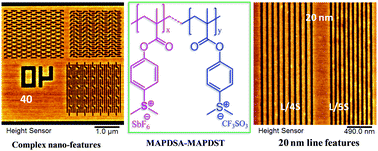Organic–inorganic hybrid photoresists containing hexafluoroantimonate: design, synthesis and high resolution EUV lithography studies†
Abstract
Although many organic polymer based photoresists are useful for patterning high resolution sub-20 nm technology nodes, many such resists suffer from poor sensitivity. One of the methods to address the problem of low sensitivity is to incorporate inorganic components into the organic polymer resist formulations. The present work demonstrates the incorporation of an inorganic counter-ion moiety, hexafluoroantimonate, into an organic polymer photoresist, poly(4-(methacryloyloxy))phenyldimethylsulfoniumtriflate (poly-MAPDST), to improve its sensitivity. This approach resulted in two novel radiation sensitive hybrid non-chemically amplified resists (n-CARs), 1.5%-&2.15%-MAPDSA–MAPDST, having different percentages (1.5%&2.15% respectively) of MAPDSA incorporated into a poly-MAPDST backbone (where MAPDSA = (4-(methacryloyloxy)phenyl)dimethylsulfonium hexaflouroantimonate). These hybrid resists are sensitive towards extreme ultraviolet (EUV, λ = ∼13.5 nm) radiation and successfully patterned high resolution 20 nm lines as well as various complex nano-features including waves, boats, line-elbows, dots and circular patterns. The sensitivity exhibited by the 1.5%-&2.15%-MAPDSA–MAPDST resists was calculated to be 58.1 mJ cm−2 and 24.5 mJ cm−2, respectively, from normalized remaining thickness (NRT) curve anaylsis, which reveals improved sensitivity as compared to the poly-MAPDST resist.



 Please wait while we load your content...
Please wait while we load your content...